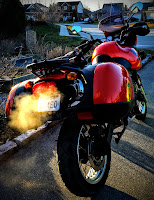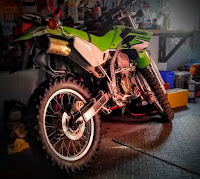 |
| This quote was used in a presentation I gave in 2013. The revolution is sneaking up on us, changing our habits and how we think and learn without us even realizing it. |
Recently a number of people have told me something along these lines: “I don’t have to remember anything any more, I can just Google it.” I don’t necessarily disagree, but this approach to off-loading knowledge does raise some interesting questions. In a best case scenario we end up with people who have the cognitive freedom to make more diverse and interesting connections, but more often I see the other side of the coin, where people are using technology to reduce their effort and involvement.
 |
| With information readily at hand, we still fall back on old concepts of information management in order to try and understand it. Computers don’t use file folders, the text we save on a computer isn’t even text, but rather than update our ideas of how information is being stored, we force it into paper based memes so we can relate inaccurately.. |
When knowledge was rare and few people read or owned books the holding of knowledge internally made you powerful. Being able to learn and retain information was a key focus of education in those days. That rigorous approach, which was a necessity because of the scarcity of information, produced tough minded academics who could dismiss the unintelligent if they couldn’t internalize what was needed. Our school system today is a historical descendant of that information scarce world – still testing students on information that is readily available to them.
Yet we still value that academic rigour, and for good reason. A student who develops the mental toughness to internalize and retain information, even if they could just Google it, is building habits that will allow them to tackle increasingly complex materials and processes, especially when that knowledge is implicit to skillsets that demand immediate response. If you’ve got to Google how to spell every word in your essay, you aren’t going to write a good essay. If you have no understanding of the French Revolution, including what led to it and what happened after, you’ll be hard pressed to create a nuanced presentation about it, no matter how handy you are at Google Presentations and searches. Using the proliferation of information as an excuse to do less is where we run into problems.
Vehicle based digital control systems offer an interesting parallel to information technology and learning. In racing the electronic subsystems that have evolved in vehicles aren’t used for safety, they are used to increase lap times and allow the vehicle operator to reach limits and stress equipment to levels before unimaginable. They don’t crash less than they used to, and when they do crash they tend to be going faster than before. Digital enhancement of driving skill is the focus of racing electronics.
Electronic controls on vehicles designed for the general public don’t increase operator ability, they leap in and interfere with it. As a skilled driver I am able to stop a car in snow in a significantly shorter distance than computer controlled anti-lock brakes (locking the wheels causes them to build up snow in front of the tires stopping the car sooner, but anti-lock braking keeps the wheels spinning, preventing that from happening). For most people who are happy to operate a two ton vehicle with no understanding of vehicle dynamics or interest in improving their skills, anti-lock brakes are a saviour – they prevent those incompetent drivers from having to care. Most cars come with anti-lock brakes nowadays for that reason. Instead of improving the humans we developed systems to take over from them.
Google’s self-driving car is the logical conclusion of the electronic controls that have been seeping into vehicles over the past thirty years. For the vast majority of people a self-driving car is a far better way of getting around than them doing it themselves because they do it so poorly. For the few who are willing to work at it, electronics could amplify their skill, but those kinds of electronics aren’t an option in cars sold to the public. The lowest common denominator (the indifferent human operator) dictates public sales and determines what everyone can have. The result of this human expectation deflation is to demand less from everyone. Even those who want to learn more eventually won’t because the skills required are obscured by mandated electronics.
The trajectory electronic vehicle controls have taken parallels the path that information technology and learning is on. If we’re not bothering to remember anything any more because we can Google it and not bothering to learn anything any more because a computer can do it, we end up at a pretty dark conclusion.
Ignorance of computers in people who use them constantly gets me so wound up because you can’t effectively use a tool if you don’t know how it works. Before school our cafeteria is full of teens using information technology with no understanding of how what they’re using works. I walked by a health class the other day and the teacher said, “you guys and your phones… I’d be happier if you were all just talking to each other (and not doing class work) than I am with you all looking at screens.” Less than 1% of students in my school take any computer courses in order to understand how they work, yet pretty much all of them depend on computers every day all day – and many teachers are expecting them to integrate that same technology into their learning.
 |
| Your modern race-car steering wheel has more in common with a space shuttle console than a wheel. |
The race car driver who is tweaking their electronics in order to improve lap times does so because they have an in depth understanding of how the technology at their disposal can improve their process. You can’t use electronics to improve your performance if you know nothing about how this technology works; modern racing drivers and engineers are all electronics experts, modern students are not and neither are the vast majority of their teachers, yet electronics continue to insinuate themselves into learning. Like the intervening vehicle management systems that assume control in order to do a better job than indifferent drivers, so educational technology is stepping in to assume control of learning for indifferent students and teachers.
Until we start treating education technology as an enhancement to learning rather than a replacement for it we remain headed on the same trajectory as the driverless car. If that is the case we’d be more pedagogically correct to ban digital tools in learning until we’ve clarified the learner as the race car driver who will understand and use educational technology to amplify their effectiveness, and not the gormless driver on public roads who needs technology to step in and do their work for them.




























